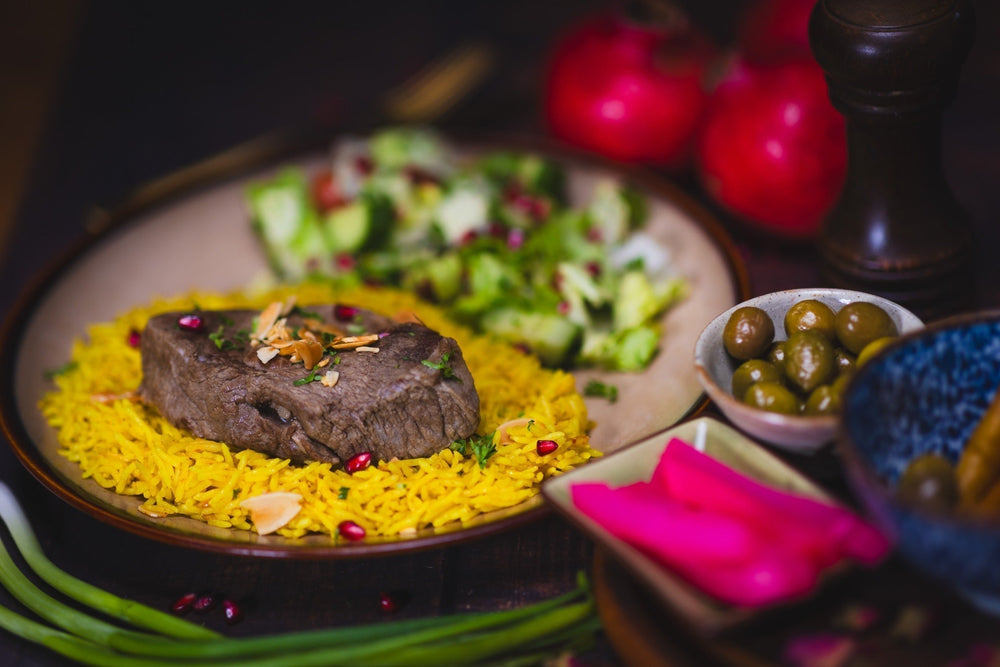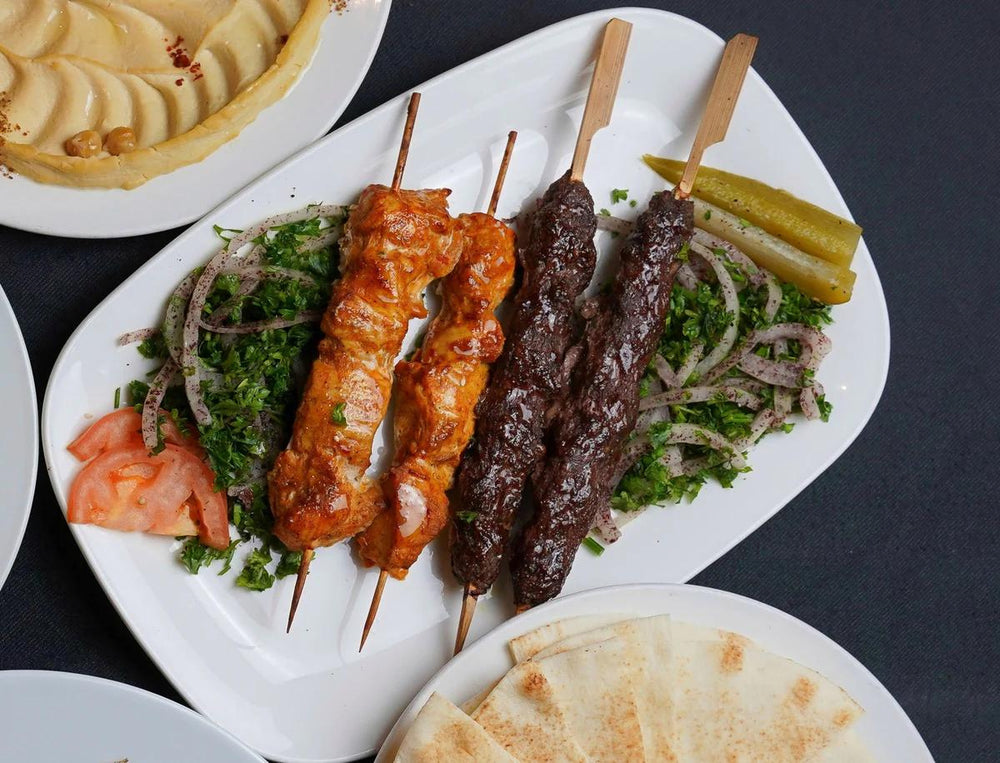Halal Meets Heat: BBQ Halal Food Ideas for Spice Lovers
Everything about the Rich Flavors and Traditions of Syrian Cuisine: A Culinary Journey
Syrian food supplies an one-of-a-kind blend of tastes and practices that show its abundant social history. With staple active ingredients like olive oil and garlic, along with a range of spices, the recipes are both diverse and inviting. From the detailed prep work of kibbeh to the wonderful appeal of baklava, each facet of this culinary landscape discloses much deeper stories. As one explores the significance of these tastes, a higher understanding of common dining and party arises.
The Essence of Syrian Ingredients
The essence of Syrian components depends on their rich diversity and deep-rooted social relevance. Influenced by the nation's varied geography and history, Syrian cuisine includes a broad range of spices, natural herbs, and fresh fruit and vegetables. Staples such as olive oil, garlic, and lemon offer a structure, while spices like cumin, sumac, and coriander include deepness and intricacy to dishes.The use of fresh natural herbs, consisting of parsley and mint, highlights the significance of seasonal components. Additionally, the area's fertile dirt returns an abundance of veggies and fruits, such as pomegranates, tomatoes, and eggplants, which are integral to lots of dishes. Grains like bulgur and rice form the base of numerous dishes, highlighting the value of these active ingredients in Syrian society. This mix of flavors shows not simply a cooking tradition yet additionally a tapestry of historical influences, making Syrian ingredients important to comprehending its food's vivid character.

Iconic Dishes of Syrian Food
Syrian food is renowned for its renowned meals that showcase an abundant tapestry of flavors and appearances. Typical meze plates use a selection of small meals that entice the palate, while hearty main dishes offer satisfying focal points for dishes (Afternoon Tea Vancouver). To finish the experience, an option of scrumptious treats includes a wonderful note to the cooking trip
Typical Meze Plates

Hearty Key Courses
Hearty main dishes act as the centerpiece of Syrian dining, showcasing a blend of tastes that show the nation's rich cooking traditions. Recipes such as kebab hindi, featuring seasoned lamb skewers, and the renowned mujaddara, a soothing mix of lentils and rice, highlight using fragrant seasonings and fresh active ingredients. One more staple is the legendary kibbeh, made from bulgur wheat and minced meat, usually served in numerous forms, consisting of baked, fried, or raw. Furthermore, the flavors of the land come to life in recipes like packed veggies, understood as mahshi, which are full of rice, meat, and natural herbs. These main dishes not only satisfy hunger yet additionally tell stories of family members events and social heritage.
Scrumptious Treats Selection
A delightful array of treats defines the pleasant side of Syrian food, using a tantalizing end to any type of meal. Among the most celebrated confections are baklava, fragile layers of phyllo bread filled with nuts and saturated in syrup, and maamoul, shortbread-like cookies typically packed with dates or nuts. Knafeh, a rich treat made from slim noodle-like pastry saturated in syrup and layered with cheese, is a prominent selection, specifically throughout cheery occasions. In addition, the sweet and fragrant rice dessert, understood as roz bil laban, provides a calming surface. These delectable treats not only display the region's cooking expertise yet also show the cultural heritage of Syria, making them treasured treats in both restaurants and homes alike.
Standard Cooking Strategies
Although contemporary benefits have affected numerous culinary practices, traditional food preparation methods remain important to Syrian cuisine. These techniques usually emphasize making use of fresh, seasonal ingredients and concentrate on sluggish food preparation to create rich flavors. Strategies such as grilling, braising, and stewing prevail, permitting the all-natural tastes of the components to beam through.One significant strategy is the preparation of kibbeh, a recipe made from carefully ground meat and bulgur. It requires experienced hand-rolling right into different forms and can be baked, deep-fried, or served raw. Additionally, the art of making bread, specifically pita, is main to numerous dishes, commonly cooked in a standard stone oven.Preservation approaches like pickling and fermenting likewise play a crucial duty, boosting the variety of flavors discovered in Syrian recipes. These techniques not only mirror the region's farming heritage yet additionally promote a solid sense of neighborhood via shared cooking methods.

The Role of Spices in Flavor
Spices act as the heart beat of Syrian food, infusing meals with complicated flavors and fragrant deepness. Each flavor plays a critical role, contributing not only to taste yet also to the cultural heritage of the area. Generally made use of flavors consist of coriander, cumin, and sumac, each providing an unique profile that elevates conventional recipes. As an example, cumin offers heat and earthiness, while sumac includes a tangy brightness, enhancing the overall dish.Syrian cooks typically blend flavors to produce unified profiles, mirroring the detailed equilibrium of tastes that specify the food. Using flavors is not merely for seasoning; it also serves to maintain food and boost its dietary value. This thoughtful incorporation highlights a deep understanding of the culinary arts, where flavors end up being vital storytellers, sharing the abundant history and varied impacts that characterize Syrian gastronomy. Inevitably, flavors are indispensable in crafting genuine and unforgettable Syrian meals.
Festive customs and celebratory meals
Commemorative meals in Syrian food are marked by traditional feast recipes that show the nation's abundant cooking heritage. Unique celebrations usually entail unique rituals that improve the public experience of dining. These customs not only recognize the value of the events but additionally strengthen social and familial bonds.
Traditional Feast Cuisines
When families collect to commemorate significant occasions in Syria, typical banquet recipes take facility phase, showcasing the rich culinary heritage of the area. These celebrations typically feature lively platters of mezze, including hummus, baba ghanoush, and tabbouleh, which offer as wonderful starters. The main dish commonly highlights lamb or poultry, marinated and prepared to excellence, usually accompanied by aromatic rice pilaf or bulgur. One of the most beloved meals is maqlooba, a layered rice recipe with veggies and meat, flipped upside down before serving. Desserts also play a critical role, with baklava and knafeh providing a wonderful coating to the dish. Each meal not just delights the palate yet additionally mirrors the deep-rooted practices and communal spirit of Syrian culture.
Special Event Routines
Special occasions in Syria are marked by rich rituals that intertwine food and celebration, mirroring the social significance of communal events. Celebratory dishes usually consist of traditional meals such as kibbeh, tabbouleh, and numerous smoked meats, prepared with care and shared among friends and family. Throughout religious holidays like Eid al-Fitr and Eid al-Adha, families come together to prepare special sugary foods like maamoul, signifying unity and delight. Wedding celebrations are particularly sophisticated, featuring multiple training courses and vibrant screens of hospitality. These occasions are not merely regarding food; they encompass music, storytelling, and dancing, reinforcing social bonds and cultural heritage. Through these rituals, Syrians commemorate life's landmarks, making sure customs are given via generations, enriching their cooking landscape.
The Relevance of Sharing and Community
Sharing dishes is a basic aspect of Syrian society, reflecting the ingrained worths of neighborhood and link. In Syria, food is not simply sustenance but a way of bringing people together. Friends and families gather around the table to take pleasure in conventional meals, promoting bonds and developing long lasting memories. This public eating experience stresses hospitality, where hosts most likely to terrific sizes to assure every visitor really feels welcomed and nourished.The act of sharing food likewise signifies generosity and solidarity, strengthening social connections within areas and bigger areas. Throughout events, it prevails for individuals to offer each other, showcasing a spirit of togetherness that goes beyond uniqueness. Events, whether large or tiny, are commonly marked by the sharing of dishes, where diverse flavors and meals integrated, mirroring the abundant tapestry of Syrian culture. As necessary, the significance of sharing and area in Syrian food is not only a cooking tradition however a vital social practice.
A Culinary Expedition of Syrian Desserts
Although frequently eclipsed by mouthwatering dishes, Syrian sweets hold a cherished place in the nation's culinary heritage. These confections show the region's rich history, mixing flavors and strategies from numerous societies. Standard treats like baklava, with its layers of phyllo pastry, nuts, and honey syrup, display the artistry associated with Syrian food preparation. Ma'amoul, a shortbread-like cookie loaded with nuts or dates, is commonly gotten ready for festive occasions, symbolizing hospitality and celebration.Another precious sweet is Knafeh, a bread soaked in syrup and split with cheese or lotion, providing a wonderful contrast of appearances. Syrians also enjoy a range of fruit syrups and preserves, usually served with tea or as part of a bigger spread throughout events. These desserts not only please the palate but additionally function as a bridge between generations, protecting the traditions and tales of Syrian society with each scrumptious bite
Often Asked Inquiries
What Are the Wellness Conveniences of Conventional Syrian Foods?
The health benefits of typical Syrian foods include abundant nutrients from fresh vegetables, beans, and entire grains. These active ingredients promote heart wellness, boost food digestion, and offer vital vitamins, contributing to overall wellness and a balanced diet plan.
Just How Has Syrian Cuisine Evolved For Many Years?
Syrian cuisine has developed significantly, influenced by historic trade paths, cultural exchanges, and local accessibility of ingredients. Standard dishes have incorporated modern-day tastes and methods while keeping their abundant heritage, reflecting a varied culinary landscape.
Exist Vegetarian or Vegan Options in Syrian Food?
Syrian cuisine supplies many vegetarian and vegan alternatives, featuring meals like falafel, tabbouleh, and stuffed grape leaves. These dishes highlight the area's abundant farming heritage, showcasing fresh vegetables, grains, and fragrant flavors in vibrant mixes.
What Beverages Pair Well With Syrian Meals?
When considering drinks that match Syrian dishes, one may find that mint ayran, pomegranate, and tea juice improve the meal's flavors. Additionally, red white wine commonly sets well with the seasonings commonly found in these foods.
Exactly How Can I Recreate Syrian Meals at Home?
To recreate Syrian dishes at home, one need to discover authentic recipes, collect typical ingredients, and utilize cooking techniques special to the cuisine. Explore flavors and presentation likewise boosts the total dining experience. Syrian cuisine is renowned for its legendary dishes that display a rich tapestry of flavors and appearances. Flavors serve as the heartbeat of Syrian food, infusing recipes with complicated flavors and fragrant deepness. Commemorative dishes in Syrian Syrian Cuisine cuisine are noted by conventional feast recipes that reflect the country's rich cooking heritage. Events, whether huge or little, are often marked by the sharing of dishes, where varied tastes and meals come with each other, showing the abundant tapestry of Syrian culture. Syrian food offers countless vegetarian and vegan options, featuring dishes like falafel, tabbouleh, and packed grape fallen leaves.